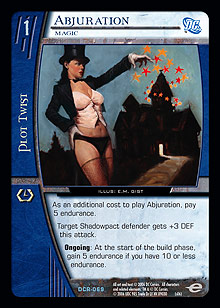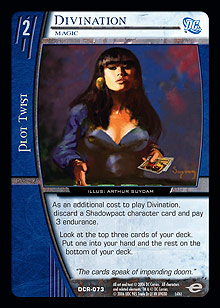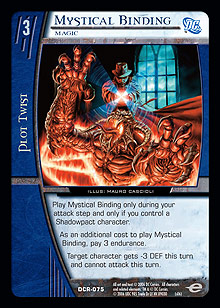Each team is unique in its own way. Often, a specific character or effect can only be found in one team. This contributes to the individual feel of a team and helps to differentiate one team from another. For example, we identify Thing with the Fantastic Four, and we know that each Green Lantern has a willpower value. Knowing these things not only adds to the flavor of the game, but it also gives us direction for our strategy.
Well, of all the teams that have graced the trade binders of TCG’ers all over the world, Shadowpact can certainly be said to be among the most unique. No team has had such powerful effects, or had to pay such a terrible price for them. Never before has a team so directly had to disadvantage itself to play its cards. When I first started drafting Infinite Crisis, I struggled with this team, and in my playgroup they quickly became the most reviled of all the affiliations of the set. However, in recent times, Shadowpact has seen a resurgence, taking out several drafts and forming a part of the deck that won $10K Adelaide. Drafting Shadowpact can be fraught with peril, but the rewards can be immense.
An important thing to realize when drafting a base Shadowpact Draft deck is that endurance loss is inevitable. There are definitely cards that give you more bang for your buck in terms of endurance loss, but on the whole, while building a competitive Shadowpact deck, some form of endurance loss is unavoidable. The key is to make that lost endurance work in your favor. Before we look at cards that are worth their cost or conducive to you having low endurance, it is worth taking some time to think about how, in general terms, being at a low endurance total affects your strategy. In effect, it can go one of two ways.
 When trying to get the most from your Shadowpact cards, my advice is to ignore the endurance gaining cards. For many players, it seems like a natural instinct to recoup the endurance lost by playing other cards that recover it. This is flawed. In Vs. System, you have limited access to cards. You need to play cards that are relevant all the time. Sealed Pack decks are only thirty cards deep. When you leave space for around eighteen to twenty characters, there isn’t a lot of space left in which to throw just any old card if you want to win. To get the most out of your cards, you need to incorporate their disadvantages into your game plan. Having cards that gain endurance incidentally, such as Rose Psychic, Ghost Detective or Abjuration, Magic, is okay; you want to evaluate each card by what it does for the endurance it costs you. Playing cards like The Oblivion Bar and Manitou Dawn, Spirit Shaman because they gain you endurance is wrong. These cards have very little effect on the game to begin with; playing them to offset other potential disadvantages you may not even suffer in some games only hides the fact that you are putting yourself at a disadvantage to begin with by playing mediocre cards.
When trying to get the most from your Shadowpact cards, my advice is to ignore the endurance gaining cards. For many players, it seems like a natural instinct to recoup the endurance lost by playing other cards that recover it. This is flawed. In Vs. System, you have limited access to cards. You need to play cards that are relevant all the time. Sealed Pack decks are only thirty cards deep. When you leave space for around eighteen to twenty characters, there isn’t a lot of space left in which to throw just any old card if you want to win. To get the most out of your cards, you need to incorporate their disadvantages into your game plan. Having cards that gain endurance incidentally, such as Rose Psychic, Ghost Detective or Abjuration, Magic, is okay; you want to evaluate each card by what it does for the endurance it costs you. Playing cards like The Oblivion Bar and Manitou Dawn, Spirit Shaman because they gain you endurance is wrong. These cards have very little effect on the game to begin with; playing them to offset other potential disadvantages you may not even suffer in some games only hides the fact that you are putting yourself at a disadvantage to begin with by playing mediocre cards.
For a deck that wants to recruit on-curve characters, having a low endurance total is worrying. Typically, on-curve decks have a strategy that deals in time. They plan on winning the long game, pushing and pulling until they can create a breach in a process that can take many turns. For decks with this sort of plan, endurance equals time, and in Vs. System, time is always slipping away. Unlike a lot of other games, endurance totals are constantly being eroded in a game of Vs. System. Very rarely will one player’s endurance total remain untouched for more than a turn. What this means is that decks do not attempt to avoid endurance loss at all; rather, they seek to minimize it. When the opponent is taking more endurance loss, it is assumed that he or she will lose the game.
When part of your overall plan is to lose endurance outside of this regular trading of endurance, you are going to have to make a move early to stem the bleeding if you want to win. When playing a curve deck, this means that you not only need to ensure that combat generates more endurance loss for your opponent than it does for you, but also that you need to take into account the endurance you lose through the normal resolution of your effects.
Fortunately, the team itself comes with built-in bonuses for when you reach a low endurance total. Typically, these are divided between effects that come online when you are at less than or equal to 25 endurance, and effects that come online when you are at less than or equal to 10 endurance. There are several cards that fit this description, so how do we know which ones are the best?
 Well, the easiest way for an on-curve deck to stem the endurance loss is to get involved in combats where its characters are not likely to be stunned, preferably through brickwalling. Generally, this means that we want to have more DEF than our opponent has ATK. For this reason, the most important Shadowpact cards are the ones that can accomplish that. The obvious cards for this plan are Dr. Occult, Richard Occult; Abjuration, Magic; and The Phantom Stranger, Fallen Angel. These are the most important cards for the team’s on-curve plan. Cards like Black Alice, Lori Zechlin; Blue Devil, Big Blue; and Zatanna, Showstopper offer the potential for large DEF as well, though the aforementioned cards are the strongest. When playing on curve, other cards should be evaluated for helping your characters remain unstunned in combat. For instance, The Conclave, Magic is a great card, not because it replicates the powerful Fizzle effect, but more specifically because it can negate combat modifiers that would allow opposing characters to stun yours.
Well, the easiest way for an on-curve deck to stem the endurance loss is to get involved in combats where its characters are not likely to be stunned, preferably through brickwalling. Generally, this means that we want to have more DEF than our opponent has ATK. For this reason, the most important Shadowpact cards are the ones that can accomplish that. The obvious cards for this plan are Dr. Occult, Richard Occult; Abjuration, Magic; and The Phantom Stranger, Fallen Angel. These are the most important cards for the team’s on-curve plan. Cards like Black Alice, Lori Zechlin; Blue Devil, Big Blue; and Zatanna, Showstopper offer the potential for large DEF as well, though the aforementioned cards are the strongest. When playing on curve, other cards should be evaluated for helping your characters remain unstunned in combat. For instance, The Conclave, Magic is a great card, not because it replicates the powerful Fizzle effect, but more specifically because it can negate combat modifiers that would allow opposing characters to stun yours.
Special mention needs to be made of Conjuration, Magic and Nightmaster, Demon Slayer. Conjuration and Nightmaster provide effects that haven’t really been seen in Vs. before, but they also ask you to pay costs that are more severe than we’ve seen before, too. In their own way, these cards offer you the potential to create favorable combats by giving you access to more resource points than you would normally have. Still, it needs to be said that these cards are much more risky than the benefits provided by the key cards posted above. When things are going badly, you will be at 25 endurance or less anyway, which will bring your best effects online (when they are going well, you will have to control this more). The application of those cards is consistent. Conjuration and Nightmaster demand that you already have the endurance and that you can afford to pay it. Due to this, you have to be careful with these cards; don’t automatically equate them to the others.
So, if we are pursing an on-curve Shadowpact plan, the most important cards are the ones that will make combat favorable for us by helping us to lose the least endurance in the long term. As mentioned above, Dr. Occult, Richard Occult; Abjuration, Magic; and The Phantom Stranger, Fallen Angel are the cornerstones of this strategy, with the latter being the most important card. Dr. Occult is excellent but is an on-board trick, so your opponent can see it coming. Abjuration is amazing, but it’s narrow in that it only works while defending and has an endurance cost that demands you not get stunned at all. The 7-drop Phantom Stranger is the best card you can have when drafting on-curve Shadowpact because it is common; the effects are cumulative when you have multiples; and best of all, your opponent cannot see it coming. You should never pass any of these cards to take anything else from this team when playing on curve.
 Finally, when taking the on-curve tack with Shadowpact, remember that you are playing to create dominant attacks. Cards like Divination, Magic and even Madame Xanadu, Cartomancer are more important than the pumps like Mystical Binding, Magic and Magical Conduit, Magic. Your plan is to fall behind in endurance and then turn it all around with massive characters that cannot be stunned later on. Ensuring that you have the right characters and support cards is more important than pumps that serve little purpose to your overall game plan. On-curve decks are much more about specific characters and situations than redundancy. You should not move into this archetype because you are wheeling several late Bindings; that leads to another deck altogether.
Finally, when taking the on-curve tack with Shadowpact, remember that you are playing to create dominant attacks. Cards like Divination, Magic and even Madame Xanadu, Cartomancer are more important than the pumps like Mystical Binding, Magic and Magical Conduit, Magic. Your plan is to fall behind in endurance and then turn it all around with massive characters that cannot be stunned later on. Ensuring that you have the right characters and support cards is more important than pumps that serve little purpose to your overall game plan. On-curve decks are much more about specific characters and situations than redundancy. You should not move into this archetype because you are wheeling several late Bindings; that leads to another deck altogether.
As referred to above, there is another way you can approach the endurance loss that the Shadowpact team inevitably incurs: you can be aggressive. In some ways, this is a riskier strategy, because while a regular aggressive deck just needs to deal more endurance loss than the opponent and end the game turns faster than the opponent wants it to, a Shadowpact deck needs to factor in the endurance loss it is already taking simply to generate effects. Still, there are a number of options that allow you to get around these disadvantages.
Firstly, I don’t want to refer to this strategy as an off-curve strategy. This is to demarcate the boundary between wanting to gain an advantage through the efficient spreading of resource points and the simple need to create board scenarios that allow you to generate incredibly one-sided attack steps. Whereas the strategy mentioned in the first part of the article stayed on-curve and sought to deal with its natural endurance loss through keeping characters face up at the resolution of combat, this plan seeks to make your cards work more efficiently for you. Stuns are going to happen here; we just need to make sure that they are grossly favorable stuns.
As mentioned a few times already, this is an extremely risky strategy. The on-curve Shadowpact plan should use a base Shadowpact deck, whereas for the aggressive plan, Shadowpact should generally be your support team. This because there just isn’t enough power in straight Shadowpact aggro, so you need to team-up with another team to get a bit more power and avoid too much endurance loss.
So, knowing that we are starting at effectively less endurance than our opponents, why would we willingly enter combats where our characters will be stunned? Because we can make those combats favorable to us. Our natural plan is to attack up the curve as much as possible. We will rely on early game characters like Nightmaster, Jim Rook and Nightshade, Eve Eden, as well as the amazing Magical Conduit, Magic. In fact, the latter is extremely important to this strategy because it ensures that we always stun in combat, continuously dropping our opponent’s endurance and keeping his or her board slim. Later in the game, anything that has a large ATK value for its cost (like Ibis, Prince Amentep and Big Blue, Dan Cassidy) will be good to have around. While we are able to attack up the curve, we increase our chances of attacking down elsewhere and will be able to gain an advantage in the endurance race.
 Still, a strategy of attacking up the curve is not enough. Infinite Crisis has been the least conducive set to such shenanigans in a long time with its common recovery and DEF-enhancing tricks. The team needs something more. Again, fortunately, there are options. Nightshade, Shadow Siren; Stepping Between Worlds, Magic; and Mystical Binding, Magic are the key cards to this archetype. The trick is to avoid combat altogether and try to attack directly as much as possible. Where you are successful in making this work, you will be dealing out endurance loss without taking any, so you will be turning your disadvantage around. More than this, when you can move the opposing characters to the hidden area, you can then use Mystical Binding to prevent them from attacking.
Still, a strategy of attacking up the curve is not enough. Infinite Crisis has been the least conducive set to such shenanigans in a long time with its common recovery and DEF-enhancing tricks. The team needs something more. Again, fortunately, there are options. Nightshade, Shadow Siren; Stepping Between Worlds, Magic; and Mystical Binding, Magic are the key cards to this archetype. The trick is to avoid combat altogether and try to attack directly as much as possible. Where you are successful in making this work, you will be dealing out endurance loss without taking any, so you will be turning your disadvantage around. More than this, when you can move the opposing characters to the hidden area, you can then use Mystical Binding to prevent them from attacking.
The goals of this deck are twofold. Firstly, have a deck that is capable of attacking up the curve at all times. This will allow you to use your plot twists and other endurance-sapping effects for advantage, not just parity. Secondly, have the capacity to move particularly troubling characters to the hidden area to encourage the above scenario. Mystical Binding is a wonderfully versatile card in this archetype, acting as insurance on attacks and protecting your endurance total. Finally, for this type of deck, having your own concealed characters can be important and should be one of the things you look for in a team-up.
Shadowpact is most certainly a team unlike any other. Their powerful effects are tempered by the most severe costs. At times, playing Shadowpact can feel like juggling anvils. The key to the affiliation is knowing how you are going to compensate for effectively starting on lower endurance than your opponent. The effects that create this position can be powerful, but only situationally. You need to know what sort of deck you are trying to build and what cards you should prioritize to make it work.